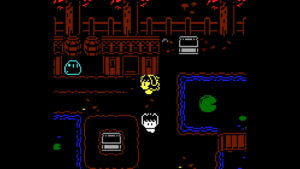Box One
I’ve talked a little about the emerging genre of puzzle-packages, a genre so new that there isn’t really an accepted name for it yet. My experience of the thing is mainly of boutique indie experiences with small runs, but more mass-market versions exist. I recently played through one that’s so mass-market, it’s sold (exclusively) at Target: Box One, presented by Neil Patrick Harris.
Now, I’m hesitant to describe this work in much detail, in part because the post-game content is so insistent that I not reveal any of its secrets. So let’s start off with vague generalities. Escape rooms and puzzle hunts are usually best solved by teams, in part because it lets the hints be vague enough to go over some people’s heads. Box One, however, explicitly bills itself as a game for one player, and that seems like the right amount to me. In fact, it may be ideally suited for half a player — that is, a player who has other stuff going on and isn’t giving the game their full attention. I’ll get into why I say this in a bit, but it’s spoilery.
Materials in and around the game put forth the narrative that “single player” was the game’s central innovation — that it was conceived not as an escape-room-in-a-box or a puzzle-hunt-at-home, but as a party-game-by-yourself, essentially a solitaire version of the previous “presented by Neil Patrick Harris” game, Amazed (which I know nothing about). This raises the question: Do the designers not know of the genre they’re participating in? I find their ignorance unlikely, but they’re not assuming that the player knows about it. (Spoilers turn up one notch every paragraph from this point onward.)
Now, as someone who was aware of the genre, and was expecting a puzzle-package, opening the box was initially disappointing to me, as it seemed that all it contained was a tall deck of “challenge cards” (to be drawn and acted on one by one, Pandemic Legacy-style), a notepad, a pen, and a large spacer to fill out the box. There ultimately turns out to be more to it, but the first phase of the game, in which you just draw cards and answer interlinked trivia questions, lasted long enough for me to genuinely think that this was all there was going to be. As a result, I was pleasantly surprised when the twist occurred, even though I had gone in expecting it. That’s a feat pulled off well.
The game turns out to have a substantial online component, which always seems a little like cheating to me. I bought this box as an alternative to playing videogames, darn it. It gives Neil Patrick Harris the opportunity for a little screen time, though, and he’s always a treat to watch. He’s basically in Doctor Horrible mode here, playing himself as a comically self-centered heavy against the story’s true hero, played by an actor who does a lot more acting than NPH but doesn’t get his name on the box. It seems a little unfair, but it’s an unfairness that’s at least in line with the story.
Everything funnels into what is essentially an escape room turned inside-out, the player using the game’s website to remotely help the hero escape captivity. But before you can get started at that, there’s a built-in delay of 24 hours. I suppose the intended effect was to split the game into two episodes — you were supposed to hit the “Come back tomorrow” and actually put the box aside and do something else. This is the game’s biggest misstep, at least for a player such as myself. For why would I stop poking around and seeking secrets, just because one avenue of progress is blocked? That’s not how you play adventure games! (And yes, I was pretty much thinking of it as an adventure game by this point.) As a result, I found most of the game’s secrets before the game led me to them, and that’s a shame, because it meant I missed out on some of the showmanship of the reveals, the “omg it was there all along and I didn’t see it until you pointed it out” factor.
For all that, it’s a pretty satisfying experience. It’s basically all about hiding information in as many ways as possible. It’s just optimized for a player who’s willing to sit down and follow directions sometimes — something it actually emphasizes in the beginning of the challenge cards. To its credit, it is also fully resettable, provided you take care not to damage the components.
 Comments(0)
Comments(0)